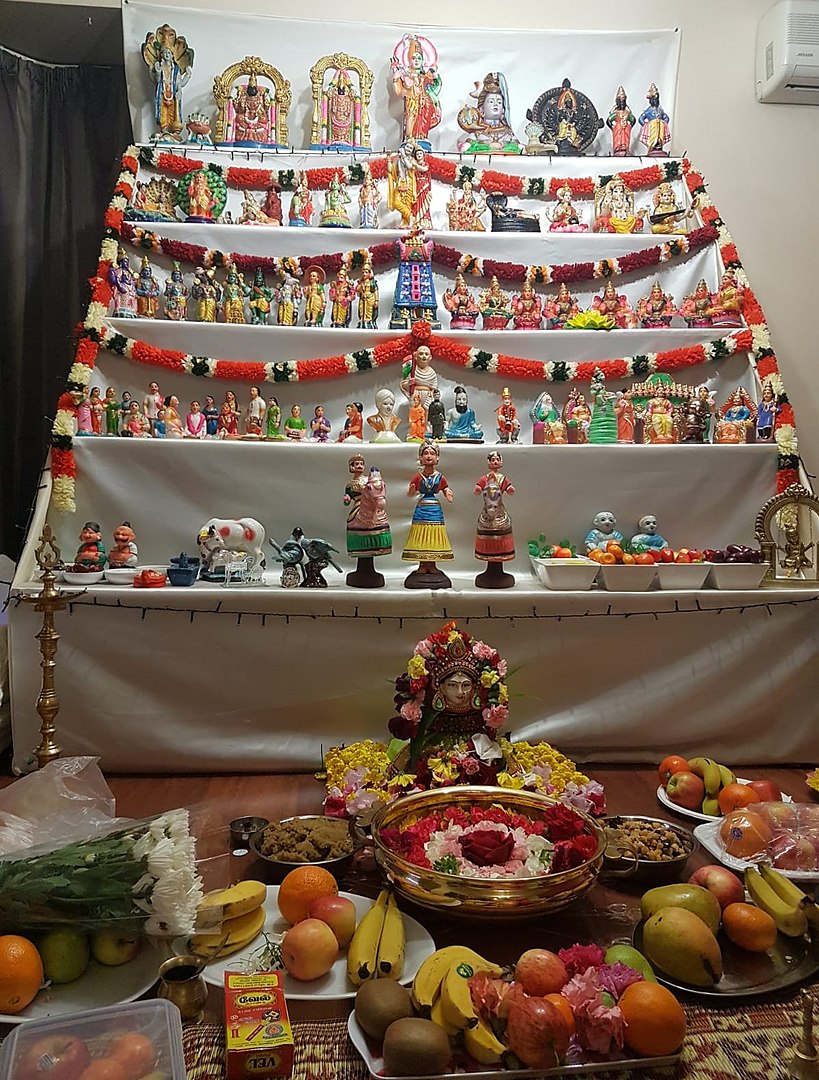Golu dolls await patiently in their crates, wrapped up in wads of newspaper, stashed away in the bottom shelves. They are an integral part of a festival that I hold very close to my heart, associating countless happy memories with it and a few not so good ones. Yes, I have broken a doll or to as a child, just as everyone else has, not that my kids know!
What made the festival so special was that I could stash my books away for later, procrastinate on holiday homework, and get away with sneaking sweets and savouries every day! But all those things weren’t even the best part!
The best part was unwrapping the Golu dolls that awaited patiently in their crates, wrapped up in wads of newspapers the year before! My mother and I would carefully remove one doll at a time and dust them in preparation for the padis!
Of all the dolls lined up on the Golu padis, I am always partial to Marapachi Bommai and the Vilacheri clay dolls. I always take stock of all the old dolls before every festive season and add a new one to my collection, as is the custom.

Golu is an essential festival in South India and equals the enthusiasm and excitement that Durga Pooja does in the north. It is a part of the Navratri/Dasara/Dussehra festivals and revolves around grandeur displays of dolls.
These displays are usually seat or created around a theme, as decided by the participating women of the household. Thus, the festival is very women-centric, calling for the worship of the various avatars of Goddess Durga and honouring her strength through its celebration.
Golu is also referred to as Kolu, Gombe Habba, Bommai Kolu or Bommala Koluvu in and around the South Indian states. The magnificent Golu displays vary from household to household in terms of size, the number of steps, kinds of dolls and the variety in settings. They also depict various scenes such as village life, legends from Hindu scriptures, wedding rituals, miniature kitchen sets, and idols. Some displays go so far as to include eminent personalities such as freedom fighters, warriors, and even singers.

Golu Padi: The Steps and Their Layout
On completing Ganapathi pooja on the first day of Navratri, the older women of the household perform Kalasa Ahvanam and welcome the Goddess Lakshmi, Goddess Saraswati and Goddess Parvati. Then the family gets together to build the Golu padis. First, a rack of an odd number of shelves is set up by family members using either iron or wooden planks and frames. Some households have a customized metal frame built in steps of 3, 5, 7, 9, or 11 to accommodate their dolls every year.
Also read: How To Set up Golu Padis From Scratch Using Cardboard Boxes
Colourful fabric is then used to wrap the shelves, creating a uniform and contrasting canvas for the dolls. Some families change the material every day to accommodate the different colour representations of the Goddess Durga or use a cloth with multiple colours.

Once the stand and steps have been wrapped, the dolls are brought in to fill them up. Dolls are often segregated based on type, size or thematic setting and occupy space on the tiers accordingly. The deities, however, are always set on the top levels and are often a part of thematic arrangements.
The top tier is always occupied by the Marapachi bommai, or the Marapachi dolls. These dolls are made of red sandalwood, teak wood, country wood, rosewood or dried coconut, depending upon the region in which they are crafted. The dolls are wrapped and decorated in new clothes every year before becoming a part of the display.
Also read: Why Marapachi Dolls are integral to Navratri
As per South Indian custom, the bride’s parents present her with a pair of Marapachi Bommai as part of her wedding trousseau. This set is given to the bride to initiate the yearly tradition of Golu in her new household and kickstarts her collection of the Golu dolls. The dolls are always in couples and represent a King/Queen or a husband and wife to symbolize prosperity and fertility and the start of the newlywed’s collection.
 Marapachi Bommai From the Ancient Madurai Studio
Marapachi Bommai From the Ancient Madurai Studio
Most of these dolls are passed on from generation to generation as heirlooms and become valuable additions to a family’s heritage as the years pass by.
Where Can You Buy Golu Dolls Online?
Golu dolls are available at numerous forums online saving us from travelling to crowded areas. Ancient Madurai offers a wide variety of Marapachi dolls available for the festivities, all from small, independent artisans that deserve appreciation and support for their craft.
The Ancient Madurai Studio also takes orders, requests and customizations for Vilacheri dolls handcrafted from locally procured clay by Vilacheri artisans.
The dolls are crafted from eco-friendly materials, and every purchase directly supports the artisans that make them.

Golu Dolls and Community Spirit
Golu is just as much a community-centric celebration as it is family-centric. On the day of Golu families visit each other in and around the neighbourhood to appreciate every woman’s creativity in their very own displays.
Women chant, sing shlokas and share and exchange delicious prasadam on their visits. Women are also given hampers of betel leaves, glass bangles, coconuts, a string of flowers, fruit and the auspicious turmeric and vermillion.
To purchase Golu dolls and sets for the festivities, click here!
To order specific items, dolls, or sets, reach out to us via email at [email protected] or DM us on our social media handles!





 Decor
Decor Pooja
Pooja Kitchen
Kitchen Statue
Statue














Thanks, I’ve been looking for this for a long time
_________________
АҚШ-тың ескі ойын автоматтары
How can I buy golu bommai online
You can order through website. Please message to this number 9786833440.This is our customer care number ,they will answer your queries mam.